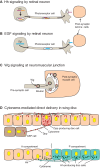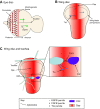Cytonemes as specialized signaling filopodia
- PMID: 24496611
- PMCID: PMC3912825
- DOI: 10.1242/dev.086223
Cytonemes as specialized signaling filopodia
Abstract
Development creates a vast array of forms and patterns with elegant economy, using a small vocabulary of pattern-generating proteins such as BMPs, FGFs and Hh in similar ways in many different contexts. Despite much theoretical and experimental work, the signaling mechanisms that disperse these morphogen signaling proteins remain controversial. Here, we review the conceptual background and evidence that establishes a fundamental and essential role for cytonemes as specialized filopodia that transport signaling proteins between signaling cells. This evidence suggests that cytoneme-mediated signaling is a dispersal mechanism that delivers signaling proteins directly at sites of cell-cell contact.
Keywords: Cytoneme plasticity; Cytoneme transfer; Drosophila; Filopodia; Gradient; Morphogen.
Figures


Similar articles
-
Cytoneme-mediated cell-cell contacts for Hedgehog reception.Elife. 2017 Aug 21;6:e24045. doi: 10.7554/eLife.24045. Elife. 2017. PMID: 28825565 Free PMC article.
-
Regulatory mechanisms of cytoneme-based morphogen transport.Cell Mol Life Sci. 2022 Feb 4;79(2):119. doi: 10.1007/s00018-022-04148-x. Cell Mol Life Sci. 2022. PMID: 35119540 Free PMC article. Review.
-
Cytoneme-mediated signaling essential for tumorigenesis.PLoS Genet. 2019 Sep 30;15(9):e1008415. doi: 10.1371/journal.pgen.1008415. eCollection 2019 Sep. PLoS Genet. 2019. PMID: 31568500 Free PMC article.
-
Improving the understanding of cytoneme-mediated morphogen gradients by in silico modeling.PLoS Comput Biol. 2021 Aug 3;17(8):e1009245. doi: 10.1371/journal.pcbi.1009245. eCollection 2021 Aug. PLoS Comput Biol. 2021. PMID: 34343167 Free PMC article.
-
Cytonemes and the dispersion of morphogens.Wiley Interdiscip Rev Dev Biol. 2014 Nov-Dec;3(6):445-63. doi: 10.1002/wdev.151. Epub 2014 Sep 3. Wiley Interdiscip Rev Dev Biol. 2014. PMID: 25186102 Free PMC article. Review.
Cited by
-
Peering into tunneling nanotubes-The path forward.EMBO J. 2021 Apr 15;40(8):e105789. doi: 10.15252/embj.2020105789. Epub 2021 Mar 1. EMBO J. 2021. PMID: 33646572 Free PMC article. Review.
-
Vangl2 promotes the formation of long cytonemes to enable distant Wnt/β-catenin signaling.Nat Commun. 2021 Apr 6;12(1):2058. doi: 10.1038/s41467-021-22393-9. Nat Commun. 2021. PMID: 33824332 Free PMC article.
-
Mathematical modeling of Erk activity waves in regenerating zebrafish scales.Biophys J. 2021 Oct 5;120(19):4287-4297. doi: 10.1016/j.bpj.2021.05.004. Epub 2021 May 20. Biophys J. 2021. PMID: 34022234 Free PMC article.
-
Apoptosis in Cellular Society: Communication between Apoptotic Cells and Their Neighbors.Int J Mol Sci. 2016 Dec 20;17(12):2144. doi: 10.3390/ijms17122144. Int J Mol Sci. 2016. PMID: 27999411 Free PMC article. Review.
-
Slik sculpts the plasma membrane into cytonemes to control cell-cell communication.EMBO J. 2025 Apr;44(8):2186-2210. doi: 10.1038/s44318-025-00401-8. Epub 2025 Mar 6. EMBO J. 2025. PMID: 40050674 Free PMC article.
References
-
- Ben-Zvi D., Pyrowolakis G., Barkai N., Shilo B. Z. (2011). Expansion-repression mechanism for scaling the Dpp activation gradient in Drosophila wing imaginal discs. Curr. Biol. 21, 1391–1396 - PubMed
-
- Bentley D., Toroian-Raymond A. (1986). Disoriented pathfinding by pioneer neurone growth cones deprived of filopodia by cytochalasin treatment. Nature 323, 712–715 - PubMed
-
- Bilioni A., Sanchez-Hernandez D., Callejo A., Gradilla A. C., Ibanez C., Mollica E., Carmen Rodriguez-Navas M., Simon E., Guerrero I. (2013). Balancing hedgehog, a retention and release equilibrium given by Dally, Ihog, Boi and shifted/dWif. Dev. Biol. 376, 198–212 - PubMed
-
- Briscoe J., Lawrence P. A., Vincent J.-P. (ed.) (2010). Generation and Interpretation of Morphogen Gradients: a Subject Collection from Cold Spring Harbor Perspectives in Biology. Cold Spring Harbor, NY: Cold Spring Harbor Laboratory Press;
-
- Callejo A., Bilioni A., Mollica E., Gorfinkiel N., Andrés G., Ibáñez C., Torroja C., Doglio L., Sierra J., Guerrero I. (2011). Dispatched mediates Hedgehog basolateral release to form the long-range morphogenetic gradient in the Drosophila wing disk epithelium. Proc. Natl. Acad. Sci. USA 108, 12591–12598 - PMC - PubMed
Publication types
MeSH terms
Substances
Grants and funding
LinkOut - more resources
Full Text Sources
Other Literature Sources
Molecular Biology Databases

